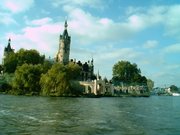Schwerin Castle
|
|
German: Schweriner Schloss
Located in the City of Schwerin, the capital of State of Mecklenburg-Western Pomerania, Germany. For centuries it had been the home of Dukes and Archdukes of Mecklenburg and later Mecklenburg-Schwerin. Nowadays it is the seat of the state parliament.
| Contents |
History
10th century
First reports of a castle at the spot were made by the Arabian merchant Ibrahim ibn Jacub in 973, who travelled the slavic area of Europe. There was a fort of the Slavic tribe of the Obotrites on an island in the large Lake of Schwerin.
12th century
In 1160, the Fort became target of Germanic noblemen planning to expand their territory to the east under the leadership of Henry the Lion (1129-1195; German Heinrich der Löwe). The Obotrites under Niklot destroyed and left the fort realising the Germanic military predominance.
However, the German conquerors recognised the strategic and aesthetically interesting located on an island and started building a new fort. The foundation of the City of Schwerin took place in the same year. Schwerin became seat of a Bishop.
In 1167, Henry gave the County of Schwerin to his feudatory Gunzelin von Hagen, and the rest of the country was returned to Niklot's son Pribislav, forming the ducal hereditary line that lasted until 1918.
14th century
In 1358, the County of Schwerin was bought by the descendants of Niklot, who had been elevated to Dukes of Mecklenburg in 1348. Soon, they relocated from Mikelenburg near the City of Wismar to the further inland Schwerin.
During the late Gothic era, the lifestyle of the Dukes had changed, and growing need for a representative castle led to architectural changes. The Bishop's House (German Bischofshaus) from that period can still be seen today.
16th century
Under Duke Johann Albrecht I. (1525- 1576), the castle saw some important changes. The fort became a castle; lifestyle and representation replaced the defense functions.
The use of terracotta during the renaissance was dominant in North German architecture. The supplies came from Lübeck.
A few years later, from 1560 to 1563, Duke Johann Albrecht I. chose to rebuild the castle's chapel. It became the first protestant new church of the state. The architecture was inspired by churches in Torgau and Dresden. The Venetian Renaissance gate, its gable showing the carrying of the cross, was made by Hans Walther (1526-1600), a sculptor from Dresden.
Windows in the northern part show biblical illustrations by well-known Dutch artist Willem van den Broecke (1530-1580; called Paludanus).
As the castle, despite its location on an island, needed additional defenses, bastions were established to the Northwest, Southwest and Southeast around the middle of the 16th century; they were probably built by the same Italian architects who, under Francesco a Bornau, also worked in Dömitz. The bastions were later modified several times, but are still standing today.
17th century
Before the Thirty Years' War, the architect Ghert Evert Piloot, who had entered Mecklenburg's service in 1612, made plans for a complete rebuild of the castle in the style of the Dutch Renaissance. In 1617, work began under his supervision, but soon had to cease due to the war. Piloot's plans were later partially put into practice between 1635 and 1643: the house above the castle kitchen and that above the chapel were raised and given Dutch Renaissance style façades.
18th century
During this period, a half-timbered building was constructed near the chapel to host the archducal collection of paintings. Also, the Teepavillon (tea house) was built.
The court moved to Luwigslust in 1756.
Schwerin_castle2.jpg
19th century
In 1837, the ducal residence moved back to Schwerin, but the building was in relatively bad condition. Additionally, the Archduke didn't like the individual buildings' incongruent origins and architectural styles.
Archduke Friedrich (1800-1842) decided to rebuild the castle, and ordered his architect Georg Adolph Demmler (1804-1886) to do so. A few months later, construction was halted by his successor, Friedrich Franz II. (1823-1883), who wanted a complete reconstruction of the historic site. Only some parts of the building from the 16th and 17th century were kept.
Dresden architect Gottfried Semper (1803-1879) and Berlin architect Friedrich August Stüler (1800-1865) could not convince the Archduke of their plans. Instead, Demmler included elements of both of them into his plan, but would find inspiration in French Renaissance castles. It became the most admired masterwork of the student Karl Friedrich Schinkel. He also planned a government building in 1825/26 located at Schlossstraße (today the State Chancellery).
Castles of the Loire river (e.g. Chambord Castle) also inspired him and contributed to the construction from 1843 until 1851.
His successor Stüler, again, changed a few things, and included a statue of Niklot on horseback, and the pompous cupola. For the interior design, Heinrich Strack (1805-1880) from Berlin was chosen. Most of it was done by craftsmen from Schwerin and Berlin.
20th century
There was a fire in the castle in December 1913. The revolution in 1918 resulted in the abdication of the Archduke, but only the exterior reconstruction had been completed. Later, it became a museum. In 1948 it became the seat of parliament. In the anti-feudalist GDR, from 1952 until 1981, it was used as a college for kindergarten teachers. Then it was a Museum again until 1993. The Orangerie had been a technical museum since 1961. From 1974 on, some renovated rooms were used as an art museum.
Since late 1990, it is once again a place of government and representation as the seat of the parliament of State of Mecklenburg-Western Pomerania. Since then, massive renovation efforts have been conducted and are, due to the complexity of a castle of this size, still in progress.
External link
- State Parliament of Mecklenburg-Western Pomerania (German) (http://www.landtag-mv.de)de:Schweriner Schloss

